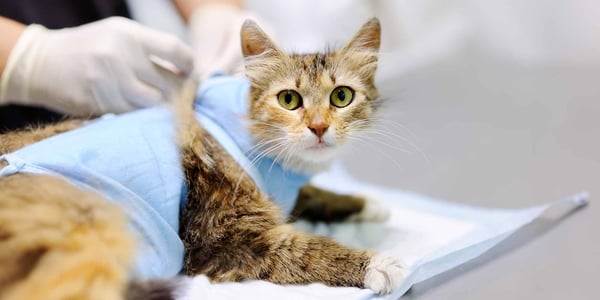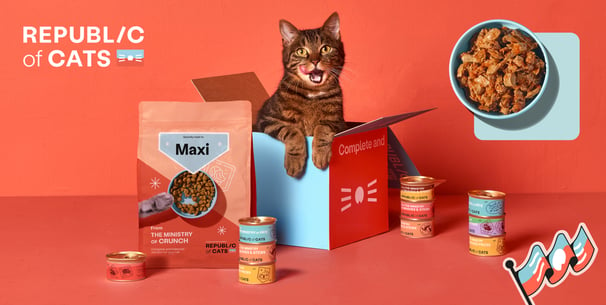Diabetes in Cats - Symptoms and Treatments
Index:



Introduction
Diabetes is a medical condition that doesn’t just affect humans, but cats too. Diabetes in cats occurs when their body either doesn’t produce enough insulin or can’t use the insulin it does produce properly. It is one of the most common hormonal (endocrine) disorders diagnosed.
Without insulin, cats can’t regulate their blood sugar leading to high blood sugar levels. This can cause a wide range of health problems.
If you want other health related help for your furry friend, then check out our other helpful content on cat diarrhoea, worms in cats, and even allergies as all these things can appear as symptoms for other diseases.
To help break everything down, we’ve created this guide where we’ll discuss:
The causes of diabetes in cats
Symptoms of diabetes in cats
Diagnosis of diabetes in cats
Treatment of diabetes in cats
Causes of diabetes in cats



Genetics
Cats with diabetes suffer most from type 2 diabetes. Type 2 diabetes occurs when the pancreas in a cat’s body can’t produce enough insulin to control the blood glucose level or when the cells don’t respond well to the insulin that is produced.
This can cause cats to suffer from hyperglycemia. In both humans and cats, diabetes can have a genetic basis meaning there are higher risks of cats developing diabetes if they’re from a family of diabetic cats.
Obesity
Environmental factors can interact with genetic factors and play a huge role in the development of diabetes in cats. Obesity and lack of exercise can impair the production of insulin and can add to an already underperforming low level of insulin resistance.
Feeding a cat a high-calorie diet or overfeeding them contributes directly to increased body weight and obesity and therefore places them at a higher rate of developing diabetes. If you are worried your cat is overweight, speaking to a vet can help you to plan an effective weight loss programme.
Inactivity
Lifestyle factors such as inactivity can also contribute to diabetes in cats. Indoor cats are typically less active than outdoor cats who often hunt and defend their territory.
A lack of exercise in cats can add to already-existent genetically-determined insulin resistance.
Pancreatitis
Pancreatitis is a very important factor and potential cause of diabetes mellitus in cats. Pancreatitis refers to an inflammation of the pancreas, an organ found near the stomach.
If a cat has both pancreatitis and diabetes, not only will they be unable to regulate their blood sugar but their pancreas will be unable to produce insulin. This can be very fatal so it is important you get your cat checked out by a veterinarian to source a diagnosis and treatment.
Other medical conditions
When it comes to diabetes in cats, things aren’t always black and white. There are other contributing factors and things that can influence the likelihood of developing further conditions such as a cat’s age, gender, and in the case of diabetes, if they are taking steroids to treat other illnesses such as feline asthma.
Feline asthma is treated with steroids, but steroids cause insulin resistance. This is something that can be discussed with your vet. Like human asthma, it can be irritated further by the environment your cat is living in. Your vet can help you to find ways to alleviate the effects of asthma and talk you through your treatment options.
Symptoms of diabetes in cats



Diabetes is a very serious condition that requires ongoing attention and treatment. By recognising any symptoms early on and maintaining your cat’s health, you can give them the best chance of avoiding the disease.
It’s estimated that over half of both cats and dogs in the world are either overweight or obese. Cats are almost 3 times as likely to develop diabetes than dogs. Though there are many risk factors involved, obesity is one of the biggest, as mentioned above.
Below, we’ve noted the top symptoms of diabetes in cats. If you notice your cat has one or more of the key signs, it’s best to get them checked out by a vet as soon as possible.
1. Increased thirst and urination
Noticed your cat drinking a lot? This could be a sign of diabetes. Cats with diabetes become very thirsty because there is too much sugar in their urine. This then draws the water out of the body making them feel dehydrated and more likely to urinate.
2. Increased hunger
Because cats with diabetes can’t break down the sugar in food for energy, they often feel very hungry. Insulin is the only hormone that allows glucose to be broken down, without the production of insulin, your cat will probably feel very lethargic and hungry.
3. Weight loss
Even cats with diabetes who display a healthy appetite can still be subject to sudden weight loss. This happens because the body’s cells process energy from protein and fat, instead of sugar. This means a loss of energy and an inability to retain muscle mass.
4. Lethargy
Hypoglycemia (low blood sugar) can result in lethargy and loss of coordination. If you’ve suddenly noticed your cat has a sudden loss of energy and is sleeping a lot more frequently, speak to your vet.
Hypoglycemia can be fatal if left untreated and can cause long-lasting effects on the function of muscles.
5. Vomiting
Cats with diabetes often have episodes of vomiting due to feelings of nausea. Vomiting isn’t the most common sign of feline diabetes but it can point to the fact that your cat’s blood glucose level isn’t being controlled.
Again, this can be fatal and requires urgent veterinary attention to make sure their condition isn’t worsening.
6. Dehydration
Dehydration is one of the biggest signs of diabetes in cats. If cats go without water for a long time, they are very likely to develop ketoacidosis. At this stage, cats do not eat or drink which can be very dangerous and fatal.
7. Depression
Because of lethargy and lack of energy, many cats with feline diabetes become depressed. During this stage, they will no longer be interested in exercising or playing and may not want to eat.
Diagnosis of diabetes in cats



Your vet will diagnose feline diabetes through a series of tests to prove a rising presence of glucose levels in a cat’s urine and blood. These tests, along with symptoms already recognised, will lead to an official diagnosis of feline diabetes mellitus.
Sometimes, having blood tests and urine tests isn’t enough. This is because some cats can develop hyperglycemia in relation to stress and anxiety without it developing into diabetes.
In cases like this, a fructosamine concentration test can be very beneficial. This test averages a cat’s blood sugar levels over a span of 2 weeks to give a more in-depth result.
The fructosamine concentration test measures a byproduct of glucose metabolism rather than the glucose itself. It is a simple test and is often used by vets in their evaluation of feline diabetes.
If you’ve noticed one or two symptoms in your cat but would like a second opinion before visiting your local vet in person, we recommend making use of Joii. Joii is an online vet care system, free for all Waggel members.
Joii allows you to book online consultations with vets and order treatments through one helpful app. You’ll also get written consultation notes sent to you after your appointment which can be very helpful when attending your next in-person vet appointment. For peace of mind, why not try Joii’s symptom checker?
Treatment of diabetes in cats



Though diabetes is a very serious disease, it can be managed and treated. The main aims of diabetes treatment are to restore normal blood sugar concentrations, stop or control weight loss, stop or minimise urination and increased thirst, and avoid low blood sugar (hypoglycemia).
Your vet will be able to help you achieve this with a full treatment programme and guidance. This means you’ll have to become familiar and confident with administering insulin injections to your cat. Though humans can take oral insulin medications to reduce blood sugar, this is not yet a possibility for cats.
The main treatment for cats with diabetes mellitus is insulin injections which should be given under the skin every 12 hours.Though the thought of administering injections can be scary, most owners feel confident doing so very quickly. The needles for insulin injections are often very small meaning cats are surprisingly quite tolerant!
Your vet will also work with you to determine the appropriate dose of insulin for your cat based on their insulin requirements and levels of glucose.
The hormone insulin helps regulate blood sugar levels, and for cats with diabetes, it is essential to maintain proper levels of glucose in the bloodstream. By carefully managing your cat's diabetes, you can help them maintain a good quality of life. Insulin treatment is just one of many treatments available for endocrine diseases like diabetes in cats.
It’s important to note that insulin therapy lowers blood sugar levels and can do so to dangerously low levels if used inappropriately. If you feel concerned for your cat, contact your vet immediately.
Another recommended treatment method is to change your cat's diet. This is also known as dietary therapy and can include prescription food options in both wet and dry forms.
A low carbohydrate diet is suggested for many cats as it can improve blood sugar levels. For overweight or obese cats, a controlled weight loss regime under veterinary supervision can significantly help to achieve control over blood sugar levels.
Ensuring your cat exercises is also a crucial step in the treatment journey. However, it’s important not to overdo it as this can cause low blood sugar levels. Introducing exercise gently through play can help your cat to feel more like their old self.
Every treatment recommendation for a cat with diabetes has to be continuously monitored. This also includes monitoring blood sugar levels. Fortunately, this can be done at home with a handheld glucometer.
A stable blood sugar level in a cat with diabetes mellitus should read at around 120-300mg/dL for a steady period of 24 hours. Though handheld glucometers are not essential, they can provide a helping hand. Your vet will also be able to suggest their own personal recommendations.
A glucometer tests for blood which means you need to collect blood from your cat. Most owners opt for the pinna (the official term for the earflap) of their cat or the paw pad. However, every cat is different so by working with your veterinarian you can work out the best site for collection.
Lots of handheld glucometers now connect to smartphones so you can measure blood glucose concentration from your phone and share the results with your vet.
Some vets may recommend oral medications such as blood sugar drops, a supplement to help manage diabetes. Products such as Blood Sugar Gold, are developed with a unique formula to support stable blood sugar levels. It also supports liver and eye health.
It’s important to note that this product is not a substitute for prescribed diabetes medication or blood-sugar-lowering drugs.
Preventing diabetes in cats



With proper diet and nutrition, diabetes in cats can be prevented. Providing a well-balanced and healthy diet can keep your cat at a healthy weight and at a lower risk of developing obesity.
Ensuring your cat takes part in regular exercise is also another surefire way of reducing the development of diabetes. There are lots of toys and ways to get your cat excited about exercise, for example, why not make playtime a fun activity to keep your cat in shape? Weight management is one of the best ways to prevent your cat from developing diabetes.
Regular checkups with your veterinarian can help to eliminate any worry and provide peace of mind. If your vet notices any symptoms, you can effectively treat them.
Conclusion
Diabetes is a very serious and chronic disease that requires constant monitoring and treatment. We hope that by reading our guide you feel more equipped and confident to help your cat if they show symptoms or are in the process of being professionally diagnosed.
Early detection and treatment are super important and can help to prevent your cat from developing additional conditions.
It’s important to take your cat to the vet if they show sudden weight loss, increased thirst, increased hunger, weight loss, lethargy, vomiting, dehydration, or signs of depression.
Though there is no cure for feline diabetes, the prognosis for a quality life is very good. Lots of cats enter diabetic remission meaning they can successfully maintain normal blood sugar levels without the need for regular insulin injections.
With professional care and prevention, you can help your cat to live a healthy life by your side. Monitoring their levels of glucose through urine and blood tests and providing the proper source of energy.
This is mainly achieved by increasing their glucose for energy increases and is crucial to managing this disease in cats.
Additionally, genetic predisposition can also play a role in the development of diabetes mellitus, so keeping an eye out for signs of diabetes mellitus and providing regular urine samples and blood tests can help catch the disease early and ensure your cat receives the best treatment possible.
So don't worry, cat owners! Any beautiful moggy can lead a happy and normal life through regular check-ups and treatment. And best of all, Waggel Pet Insurance will be here to help.
Waggel Pet Insurance
Need more help? You're in luck if you're a Waggel Pet Insurance member. Along with our excellent coverage, we offer access to a 24/7 online vet to answer all your sticky questions, especially if you need grooming assistance.
Not a member? Why not get a quote now and cover your furry friend for a range of illnesses, all while enjoying our amazing perks and rewards.
Want more like this?
Get updates from us with helpful info, advice, answers to frequently asked questions and much more.
Index:
Related posts:
Get your quote
Along with our excellent coverage, we offer access to a 24/7 online vet to answer all your sticky questions.





